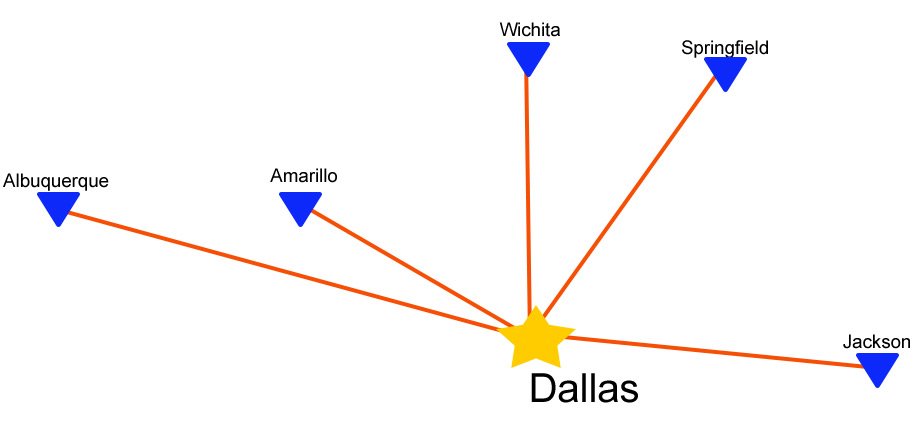Feb 10 2015
It’s the question we’re asked all the time …
“Does the airport have non-stop flights to __________ ?!”
You can fill in that blank with the destination of your choice. I keep a list. There’s Ft. Wayne, Indianapolis, Little Rock, Flagstaff, Hartford, Centralia, Illinois; Muncie, Eau Claire, the list goes on and on…
I’ve gradually realized that some folk have what amounts to a fantastic vision of how the airline business works. I’m not being critical — it’s just what they think.
Here’s how the vision goes …
“The airlines offer (or should offer) dozens of flights every day from Springfield. These flights fly non-stop to dozens of destinations in all fifty states.”
There’s just one problem …
That’s not how the airlines work —if an airline tried it would be bankrupt in about five minutes. Here’s what they do instead …
Rather than flying from Springfield to a whole bunch of places, the airlines fly from Springfield to a few “hub” cities. This is called hub and spoke flying. Let’s explain how it works by using American Airlines as an example.
Suppose you want to fly from Springfield to Amarillo. To get you there American flies you from Springfield to Dallas. At Dallas you get on another flight that takes you to Amarillo. In this scenario Springfield and Amarillo are the “spokes,” and Dallas is the “hub.”

Take a look at the diagram. The “hub” is Dallas. The smaller cities are the "spokes." On any given day a handful of customers in each spoke city want to fly to Amarillo. Rather than provide a flight from each of those cities to Amarillo, American flies them to Dallas where they’re gathered up (from all those spoke cities) and then flown to Amarillo on a different flight. (Note: this diagram shows only a fraction of Dallas' spoke cities.)
I hope you noticed the bold face in the phrase, handful of customers. This is a key point. On any given day there aren’t enough people who want to fly to Amarillo, in each of those spoke cities, to justify the cost of a non-stop flight. So the airline gathers them in Dallas and then sends them on to Amarillo.
I talk to people on a regular basis who think there are tons of people who fly (or want to fly) from Springfield to places like Amarillo. The truth is surprising …
In 2013 an average of 1.2 people per day flew from Springfield to Amarillo. That many people won’t fill the smallest plane that an airline is going to use — a 50 seat regional jet. Let’s put it another way: an airline isn’t going to fly that plane between Springfield and Amarillo if, on average, 48 seats are empty.
Now wait … there’s someone out there reading this who’s thinking, “If they had a non-stop flight to Amarillo more people would fly there!”
The airlines know from experience that “provide the service and they will come” doesn’t always work. Just because the service is there doesn’t mean that the number of people who want to fly to Amarillo, on a daily basis, is going to change enough to make the route a money maker.
Let’s talk some more about passenger numbers and where those passengers want to go — because really, when you get right down to it, this is the nitty-gritty math that the airlines deal with …
Take a look at the top ten destinations for people flying from Springfield in 2013. The numbers represent passengers using the three airlines, serving Springfield, which have daily service: American, Delta, and United:
- Atlanta: average number of people each day: 40.7. Non-stop
- Dallas: average number of people each day: 37.5. Non-stop
- Chicago: average number of people each day: 29.9. Non-stop
- Los Angeles: average number of people each day: 22.5. Must connect
- Denver: average number of people each day: 21.3. Non-stop
- New York City: average number of people each day: 18.8. Must connect
- Orlando: average number of people each day: 16.2. Must connect
- Seattle: average number of people each day: 15.7. Must connect
- Philadelphia: average number of people each day: 15.3. Must connect
- Boston: average number of people each day: 14.6. Must connect
So how come we have service? This gets complicated, so please bear with me …
The Springfield to Dallas service is the busiest route we have — approximately 400 people a day use it, but only 38 make Dallas their final destination. The rest take a connecting flight from Dallas to go to their final destination.
Let’s go back to our Amarillo example …
If we asked an airline for non-stop service to Amarillo, we’d politely be told, “No, it’s a money loser. You can already get there by connecting through Dallas.”
And the same goes for Ft. Wayne, Indianapolis, Little Rock, Flagstaff, Hartford Centralia, Illinois; Muncie and Eau Claire … and almost anywhere else we can name …
Here’s a bottom line point: at minimum, anytime we ask an airline for new daily service, it must be for a city that is a major airline hub. And to take it a step further ….
When an airline considers adding service from a small market, such as Springfield, to a big hub, it’s not just asking how many people want to fly from Springfield to that hub airport. It’s asking how many people it can connect beyond the hub, and how much revenue will those connecting customers generate?
It’s complicated. Please ask questions ....
-KB


